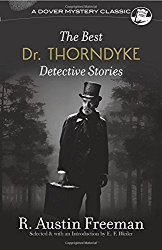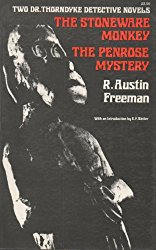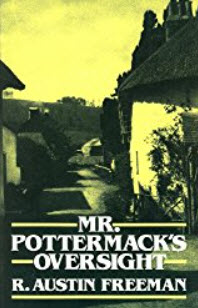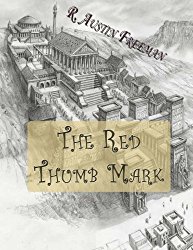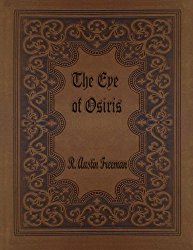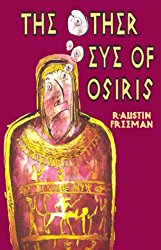Dr. Thorndyke
by R. Austin Freeman
"There is no type of fiction that is more universally popular than the detective story. It is a familiar fact that many famous men have found in this kind of reading their favourite recreation, and that it is consumed with pleasure, and even with enthusiasm, by many learned and intellectual men, not infrequently in preference to any other form of fiction."
-- R[ichard] Austin Freeman, The Art of the Detective Story
I had searched for Dr. Thorndyke books to add to my collection for quite some time. Twice over a period of several years I ran across an odd volume in one of New York City's murder mystery bookstores. But each time it was way beyond my budget. (I seem to recall a price around $125 for each volume.)
Then the very excellent Dover Publications reprints of several Thorndyke books came to my attention. These "trade size" books (about the size of a hardcover but actually extremely durable paperbacks. I still have them some thirty years later, I've read them several times, and they are still intact -- far from falling apart, Dover Books are built to last).
These were my introduction to Dr. John Evelyn Thorndyke -- a detective in a class by himself.
- "The Mystery of 31, New Inn" -- a novelette that introduced Thorndyke, and which author R[ichard] Austin Freeman later developed into a novel -- is a simply fascinating account of how arsenic poisoning can be administered so that the victim could breathe it in (rather than the typical administration in food or drink, which is so commonly used in fiction). It also demonstrated how the detective could scientifically evaluate the method used to administer the poison.
- This same Dover volume (The Best Dr. Thorndyke Detective Stories) included some short stories about Dr. Thorndyke, including the world's first "inverted" detective story. (Read "The Case of Oscar Brodski" for FREE in the Reading Room.) Freeman decided to try something entirely new in detective fiction: Begin with the crime, show the reader everything from the criminal's plan to the execution and getaway; the reader now knows all -- who the criminal is, exactly why and how he committed the crime (step by step), and what he did to cover up his trail. Then bring the detective into the case; let the detective scientifically examine the clues; finally, let him reveal in detail his analysis of the evidence. The result is astounding, as you'll see when you read it for yourself. (Freeman was to produce half-a-dozen two-part "inverted" short stories that used this technique.)
- A second Dover reprint included two novels. The Stoneware Monkey and The Penrose Mystery: Two Dr. Thorndyke Detective Novels also demonstrated scientific analysis and explication.
- A third Dover book reprinted the "inverted" full-length novel -- Mr. Pottermack's Oversight, in which Dr. Thorndyke discerned from a series of photographs that something was amiss. (The photographs were of a series of footprints made by a pair of shoes worn by a man walking along a dirt path. At some point, Dr. Thorndyke discerned a discrepancy worthy of his investigation.)
|
Click Image to Click the image below to |
Click Image to Click the image below to |
|
These books whetted my appetite for more Thorndyke novels and stories. And then one of life's little miracles occurred. I was working on a contract assignment which I discovered, to my delight, was a ten-minute walk from a used bookstore. Every week I would visit the bookstore, naturally gravitate to the mystery section, and continue my quest for Dr. Thorndyke (to no avail). Then, on the very last day of my assignment, I made my now-traditional weekly visit to the bookstore. To my amazement, I beheld a shelf full of Dr. Thornyke books. It was providential! For a mere $250.00 I acquired 23 books, including a complete set of Dr. Thorndyke. Oh, ecstasy! |
Click Image to Click the image below to |
|
Click Image to Click the image below to |
The first Dr. Thorndyke novel, The Red Thumb Mark, is a classic examination of whether (and how) fingerprints can be forged. Other volumes analyzed how nicotine can be used to murder someone, how quicklime really works (contrary to what is assumed in much fiction, quicklime can act as a preservative instead of dissolving remains), and much more. Freeman's articulation was so scientifically accurate that his books became required reading in police acadamies for a generation. Thorndyke books were in the forefront of detective fiction for nearly forty years, but when Freeman died they went out of print and largely unavailable for many years. Occasionally an odd volume or two will be reprinted, and one publisher reprinted the entire Thorndyke series, including a two versions of The Eye of Osiris (the second version -- apparently from a different manuscript version by Freeman -- he appropriately titled The Other Eye of Osiris). |
|
Click Image to Click the image below to |
Click Image to |
When I first began reading them, I thought the dialogue was stilted and old-fashioned. And so it was. I later learned, however, that it was absolutely authentic -- that if you could walk arm-in-arm with the professionals of the day, the topics and themes discussed and the conversations held would have been very close (perhaps verbatim in some cases) to what Freeman captured. Somehow this knowledge makes the books even more real and exciting.
One criticism that fans and reviewers have of Freeman is that he doesn't always "play fair" with the reader. It is the tradition of the detective story writer from Poe onward to provide all the clues up front so that the reader feels he or she can at least have a fighting chance at challenging the detective in solving the case first. Freeman gives all the clues up front, all right, but in scientific jargon that the reader requires special knowledge to decipher. For example, he tells the specific measurements of blood corpuscles found on a suspect's coat. Special knowledge is necessary to recognize that the measurements given are of chicken blood, not human blood.
In spite of this, Dr. Thorndyke books are absolutely unlike anything else in crime, murder mystery, and detective fiction. Freeman, as well as his detective, are unique. Most writers of detective and mystery fiction learned their craft from reading other writers of the genre. Freeman avoided reading other mystery writers. Instead, he developed his own plots and conducted his own scientific experiments and measurements. Rather than create an eccentric character in the mold of every fictional detective from Poe's Dupin to Doyle's Holmes, Freeman's detective -- Dr. John Evelyn Thorndyke -- is absolutely normal. (Freeman wanted him that way!) The result is an outstanding series of books that is to be sought after. The Thorndyke books should remain in print perennially.
Dr. Thorndyke books:
- The Red Thumb Mark (1907)
- John Thorndyke's Cases (1909; in America, Dr. Thorndyke' s Cases)
- The Eye of Osiris (1911; in America, The Vanishing Man)
- The Other Eye of Osiris (An alternate version of The Eye of Osiris)
- The Singing Bone (1912; in America, The Adventures of Dr. Thorndyke; 5 stories)
- The Mystery of 31, New Inn (1912)
- A Silent Witness (1914)
- The Great Portrait Mystery (1918; 7 stories)
- Helen Vardon's Confession (1922)
- Dr. Thorndyke's Case Book (1923; in America, The Blue Scarab; 7 stories)
- The Cat's Eye (1923)
- The Mystery of Angelina Frood (1924)
- The Puzzle Lock (1925; 9 stories)
- Shadow of the Wolf (1925)
- The D'Arblay Mystery (1926)
- A Certain Dr. Thorndyke (1927)
- The Magic Casket (1927; 9 stories)
- Flighty Phyllis (1928)
- As a Thief in the Night (1928)
- Mr. Pottermack's Oversight (1930)
- Pontifex, Son and Thorndyke (1931)
- When Rogues Fall Out (1932; in America, Dr. Thorndyke's Discovery
- Dr. Thorndyke Intervenes (1933)
- For the Defence: Dr. Thorndyke (1934)
- The Penrose Mystery (1936)
- Felo de Se? (1937; in America, Death at the Inn)
- The Stoneware Monkey (1938)
- Mr. Polton Explains (1940)
- The Jacob Street Mystery (1942; in America, The Unconscious Witness)
The Romney Pringle Stories (Non-Thorndyke)
Writing as Clifford Ashdown, Freeman and J.J. Pitcairn) produced two books about the rogue Romney Pringle, and another book:
- The Adventures of Romney Pringle (1902; 6 stories)
- The Further Adventures of Romney Pringle (1969; 6 stories)
- From a Surgeon's Diary (1975; 6 stories)
Other Non-Thorndyke Books
- The Exploits of Danby Croker (1916)
- The Uttermost Farthing (1914; in America, A Savant's Vendetta)
- The Surprising Experiences of Mr. Shuttlebury Cobb (1927)
Amazon and the Amazon logo are trademarks of Amazon.com, Inc. or its affiliates.
(This is a link through which I make a small commission if you buy. See here for more details.)
